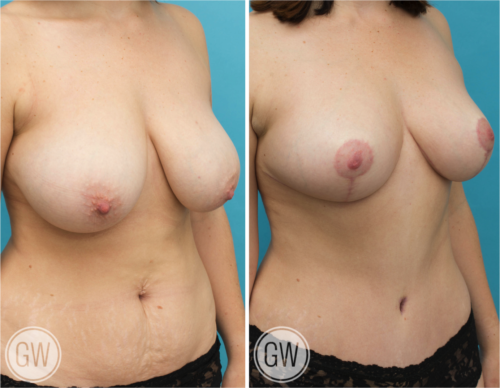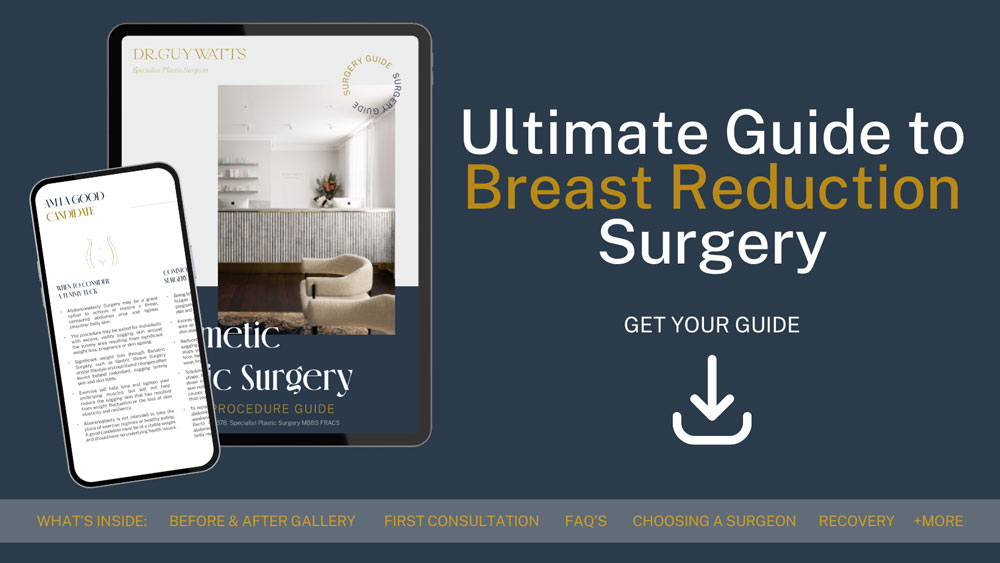
08 Nov Options for Heavy Breasts – Breast Reduction
Causes and Options for Heavy Breasts
For many women, large breasts represent more than just an aesthetic feature; they symbolise a daily struggle. The physical burden often manifests as discomfort. These challenges, amplified in social situations, drive some to consider Breast Reduction. This surgical procedure can alleviate physical discomfort.
Dr Guy Watts is an experienced plastic surgeon based in Perth, Australia and a good option for your Breast Reduction surgery.
Take our quiz, and find out if you are ready for surgery
Causes of Heavy Breasts
While genetics play a primary role in determining breast size, several other factors can contribute to having large breasts:
Your genes set the foundation for your breast size, but there’s more to it than just DNA.
- Hormonal Changes: Your body goes through a lot of changes at different stages of life. Significant shifts in hormones, particularly during moments like puberty, pregnancy, or menopause, can have a direct impact on your breast size. For instance, during puberty, increased production of estrogen can lead to breast growth. Similarly, pregnancy brings about hormonal shifts that prepare the body for childbirth and breastfeeding, which often enlarges the breasts.
- Weight Gain: As your body weight increases, it’s not unusual for your breast size to grow as well. Breasts are composed partly of fatty tissue, so as you gain weight, some of that fat can deposit in the breasts, increasing their size.
- Breastfeeding: If you’re nursing, you might notice your breasts are bigger than usual. That’s because your body is producing milk, and the milk ducts enlarge to store it, resulting in larger breasts. It’s a part of the breastfeeding process, and once you’ve stopped nursing, they often return to their previous size, although they might not be as firm as before.
- Medications: It’s essential to know that some medications can have side effects that influence breast size. For example, certain birth control pills, hormone replacement therapies and even some types of antidepressants can lead to an increase in breast size.
Physical Implications of Heavy Breasts
Having large breasts often isn’t just an aesthetic concern. It can also lead to a range of physical issues that can impact daily life.
- Neck, Back, and Shoulder Pain: Carrying the weight of large breasts can place considerable strain on your upper body. The constant pull can lead to ongoing discomfort or pain in the neck, back, and shoulders. Over time, this can become chronic and may require medical intervention or therapies for relief.
- Poor Posture: The weight of large breasts can make one lean or hunch forward. Over time, this can lead to posture issues, which not only affect appearance but can also compound the neck and back pain you might already be experiencing.
- Skin Irritation: Underneath the breast crease is an area that often experiences skin issues. Due to moisture and friction, this area can be prone to rashes, chafing, or even infections.
- Limitation in Physical Activities: Engaging in physical activities, especially high-impact exercises like running or jumping, can be challenging with large breasts. The weight can hinder specific movements, and without adequate support, can even lead to pain or injury.
DOWNLOAD DR WATTS’ GUIDE TO BREAST REDUCTION

What Is Breast Reduction?
Breast Reduction, also known as Reduction Mammoplasty, is a procedure designed to decrease the size of the breasts, alleviating many of the issues associated with large breasts. By removing excess fat, glandular tissue, and skin, the surgery can offer physical relief and changed breast appearance.
Though the specifics of the procedure can vary depending on individual needs and your plastic surgeon’s methods, here’s a general overview of what you can expect during the process:
- Anaesthesia: You’ll be given general anaesthesia for your safety and comfort throughout the procedure.
- Incisions: Dr Guy Watts will make incisions on your breasts. The pattern and size of these incisions will depend on the volume of tissue to be removed and your personal anatomy. Remember, every effort is made to keep scars as inconspicuous as possible, though their visibility will also depend on individual healing.
- Tissue Removal: Once the incisions are made, Dr Watts will remove excess skin, fat, and glandular tissue. This step is essential to reduce the size of your breasts and to make sure they’re proportional to your body frame.
- Reshaping: After the necessary tissue is removed, Dr Watts will reshape the remaining breast tissue. At this stage, the nipple and areola might be repositioned to fit the new breast shape.
- Closing Up: Finally, the incisions will be closed. This is done using sutures, and in some cases, surgical tape or skin adhesives. Over time, these incisions will heal, and while scars will remain, they often fade and become less noticeable.
Recovery and Aftercare
Following a Breast Reduction procedure, it’s vital to prioritise your health and well-being as well as optimising your results. Here are some aspects to consider during your recovery:
- Rest: Post-surgery, your body needs time to heal. While you might feel eager to return to your regular routine, it’s essential to take a step back and rest. For the initial weeks, you should avoid lifting heavy items or engaging in strenuous activities. Listen to your body; if you feel any discomfort, it’s a sign to slow down.
- Medication: To manage any pain or discomfort, Dr Watts might prescribe painkillers. It’s important to take these as directed to make your recovery as comfortable as possible. Additionally, antibiotics might be given to ward off potential infections. Make sure to complete the full course, even if you’re feeling well. This is to make sure any potentially harmful bacteria is fully eradicated.
- Follow-up visits: Your journey doesn’t end once the surgery is over. Regular check-ups with your plastic surgeon are an integral part of the recovery process. These visits allow Dr Watts to monitor your healing, address any concerns, and guide you on further care. It’s a good practice to keep all your appointments and not skip any, as consistent monitoring can prevent complications in the future.
Factors to Consider Before Choosing Breast Reduction Surgery
Before opting for Breast Reduction surgery, you should consider various aspects to make an informed decision.
Risks Associated with Breast Reduction
While there are several potential benefits of Breast Reduction surgery, it’s important to be informed about the potential risks.
- Scarring: Any invasive surgery will leave scars, and Breast Reduction is no exception. The extent and location of these scars depend on the technique used by your plastic surgeon and your body’s healing process. Over time, scars generally become less noticeable, but they will never disappear completely.
- Loss of Sensation: A change or loss of sensation in the nipples or breasts can occur after the surgery. For many, this change is temporary, but there’s a possibility it could be permanent. It’s essential to discuss this with Dr Watts, so you know what to expect.
- Uneven Breasts: Surgery aims to achieve symmetry, but there’s a chance the breasts will have some asymmetry. Slight discrepancies are to be expected but considerable asymmetry can be addressed in follow-up procedures if needed.
- Complications: As with any surgical procedure, there are potential complications. These might include bleeding, infection, or adverse reactions to anaesthesia.
Dr Watts will go through all your potential risks and complications during your consultation prior to surgery.
Cost and Insurance Coverage
Finally, the financial aspect cannot be ignored:
- Procedure cost: The price varies based on location, plastic surgeon’s experience, and specifics of the procedure.
- Insurance: Some insurance plans may cover some of the cost of the surgery if it’s deemed medically necessary.
- Other expenses: Costs like post-surgery garments, medications, and missed work should be factored in.
Making an Informed Decision
It’s imperative for anyone contemplating Breast Reduction surgery to gather as much information as possible, consult with professionals, and weigh the potential benefits against the potential downsides. Here are some steps to guide you:
Consultation with a Plastic Surgeon
A detailed discussion with a specialist plastic surgeon is indispensable:
- Examine credentials: Make sure the plastic surgeon has the necessary qualifications and experience.
- Understand the procedure: Get a clear picture of what the surgery entails, recovery time, and possible complications.
- Ask for before-and-after photos: Viewing the plastic surgeon’s previous work can help provide a realistic expectation of results.
Preparing for Surgery
Once the decision to proceed with surgery is made, preparations should commence:
- Medical evaluations: Undergo any required tests or evaluations to make sure you’re in good health.
- Medication adjustments: Some medications or supplements may need to be stopped or adjusted before surgery.
- Lifestyle changes: Quit smoking, reduce alcohol intake, and make sure you consume a balanced diet for optimal healing.
Setting Realistic Expectations
While Breast Reduction can offer relief and other potential benefits, setting realistic expectations is key:
- Aesthetic results: Understand that perfection is not the goal, but alteration.
- Physical relief: While many experience dramatic relief from pain, individual results may vary.
- Emotional outcomes: The surgery can lead to increased comfort and alter the physical appearance, but it’s essential to recognise that it won’t necessarily resolve emotional or psychological challenges.
FAQs about Breast Reduction Surgery
How long does it take to recover from Breast Reduction surgery?
- Recovery time can vary from person to person. Generally, most patients can return to work within 1-2 weeks, but it may take several weeks before you can resume strenuous activities or heavy lifting. It’s important to follow Dr Watts’ recommendations for optimal recovery.
Will my health insurance cover the cost of a Breast Reduction?
- In Australia, health insurance may cover some of the costs of Breast Reduction if it’s deemed medically necessary, for example, due to back pain, neck pain, or other physical symptoms.
- It’s advisable to consult with your insurance provider and plastic surgeon beforehand to understand any out-of-pocket expenses.
What is the right age to have a Breast Reduction?
- While there’s no specific ‘right age’, Dr Watts recommends waiting until the breasts have fully developed. However, in cases of significant discomfort or emotional distress, surgery might be considered earlier.
- It’s also worth noting that if you plan on breastfeeding in the future, this could be impacted by the surgery.
How long will the results last?
- Breast Reduction results are long-lasting. Factors like weight gain, pregnancy, and ageing can alter the shape and size of your breasts over time. It’s essential to maintain a stable weight and lead a good lifestyle to make sure the results are long lasting.
Are there non-surgical alternatives to Breast Reduction?
- While there are some non-surgical treatments that might reduce the size of the breasts slightly, such as weight loss or certain medications, they may not offer the same significant or targeted results as surgical Breast Reduction.
- You should always consult with a medical professional about the most effective options for your individual circumstances.
Further Reading about Breast Surgery with Dr. Guy Watts
- Read Dr. Watts’ Blog about Exercising after Breast Reduction
- Read Dr Watts’ Blog about How to Reduce Bruising after Breast Reduction
- Read Dr Watts’ Blog about Neck Pain and Breast Reduction
- Read Dr. Watts’ Blog about Breast Reshaping with Fat Grafting
- Read Dr. Watts’ Blog about Will Medicare Cover My Breast Reduction?
- Read Dr. Watts’ Blog about Breast Augmentation Perth
- Read Dr. Watts’ Blog about Breast Reduction
- Read Dr. Watts’ Blog about Breast Lift
- Read Dr. Watts’ Blog about What Symptoms can be Experience During Breast Reduction Recovery
- Read Dr Watts’ Blog about How to Choose the Compression Garments after Breast Reduction
Medical References about Breast Reduction
- Breast Reduction Surgery – Mayo Clinic
- Breast Reduction Surgery: Everything You Need to Know – Medical News Today
- Breast Reduction Surgery – WebMD
- Breast Reduction – Cleveland Clinic
- Breast Reduction – NCBI
About Dr. Guy Watts – MED0001539378
FRACS (Plas) – Specialist Plastic Surgeon In Perth WA
Dr. Guy Watts is a Specialist Plastic Surgeon (AHPRA MED0001539378) with an extensive career that spans across renowned plastic surgery clinics worldwide. His experience has been honed through invaluable experiences at esteemed establishments such as the New York Eye and Ear Infirmary and the renowned Pitanguy Clinic in Brazil.
Having collaborated with the foremost cosmetic plastic surgeons on a global scale, Dr. Watts has chosen to return to Perth after a 17-year journey of intensive training and invaluable professional experience to bring the latest practices and technology in cosmetic plastic surgery to his patients.
Dr. Watts is a Fellow of the Royal Australasian College of Surgeons (FRACS) and a Member of the Australian Society of Plastic Surgeons (ASPS), Australasian Society of Aesthetic Plastic Surgeons (ASAPS) and the International Society of Aesthetic Plastic Surgeons (ISAPS).
Read about the potential Risks and Complications of Surgery
Read the Patient Information and Resources
About CLINISPA
Clinispa is Dr Watts’ bespoke medical clinic performing Cosmetic Aesthetic treatments. At Clinispa, we offer advanced clinical treatments in a luxurious and calming environment, tailored to support your skin’s health and appearance.
Clinispa aesthetic services are performed by Dr Guy Watts’ nursing professionals, who have a passion for and solid understanding of facial aesthetics.
All Clinispa clients are considered individually, with a personalised treatment plan consisting of advanced scientific approaches to cosmetic aesthetics. We incorporate innovative technologies in conjunction with superiorly formulated skin care.
For more information about the full range of Clinispa Aesthetic of Cosmetic Treatments visit the Clinispa website








Sorry, the comment form is closed at this time.